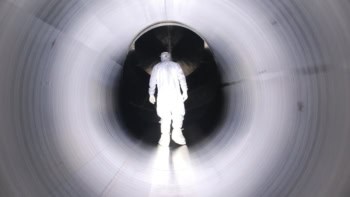
A novel particle trap invented at CERN could allow physicists to measure the magnetic moments of antiprotons with higher precision than ever before. The experiment, carried out by the international BASE collaboration, revealed that the magnetic moments of the antiparticles differ by a maximum of 10–9 from those of their matter counterparts.
One of the biggest mysteries in physics today is why the universe appears to be made up almost entirely of matter and contains only tiny amounts of antimatter. According to the Standard Model, our universe should be largely matter-less. This is because when the universe formed nearly 14 billion years ago, equal amounts of antimatter and matter were generated. When pairs of these antimatter and matter particles collided, they annihilated and produced a burst of energy. This energy created new antimatter and matter particles, which annihilated each other again, and so on.
Physicists have been trying to solve this enigma by looking for tiny differences between a particle (such as a proton) and its antiparticle. If successful, such differences (even if extremely small) would shed more light on antimatter–matter asymmetry and perhaps even reveal physics beyond the Standard Model.
The aim of the BASE (Baryon Antibaryon Symmetry Experiment) collaboration is to measure the magnetic moment of the antiproton to extremely high precision and compare it with the magnetic moment of the proton. To do this, the researchers are using Penning traps, which employ magnetic and electric fields to hold a negatively charged antiproton, and can store antiprotons for years.
Quicker cooling
Preparing individual antiprotons so that their spin quantum states can be measured, however, involves cooling them down to extremely cold temperatures of 200 mK. Previous techniques took 15 h to achieve this, but BASE has now shortened this cooling time to just eight minutes.
The BASE team achieved this feat by joining two Penning traps to make a so-called “Maxwell’s demon cooling double trap”. The first trap cools the antiprotons. The second (referred to as the analysis trap in this study) has the highest magnetic field gradient for a device of its kind, as well as improved noise-protection electronics, a cryogenic cyclotron motion detector and ultrafast transport between the two traps.
The new instrument allowed the researchers to prepare only the coldest antiprotons for measurement, while at the same time rejecting any that had a higher temperature. This means that they did not have to waste time cooling down these warmer particles.
“With our new trap we need a measurement time of around one month, compared with almost 10 years using the old technique, which would be impossible to realize experimentally,” explains BASE spokesperson Stefan Ulmer, an experimental physicist at Heinrich Heine University Düsseldorf and a researcher at CERN and RIKEN.
Ulmer says that he and his colleagues have already been able to measure that the magnetic moments of protons and antiprotons differ by a maximum of one billionth (10–9). They have also improved the error rate in identifying the antiproton’s spin by more than a factor of 1000. Reducing this error rate was one of the team’s main motivations for this project.

Antimatter does not fall up, CERN experiment reveals
The new cooling device could be of benefit to the Penning trap community at large, since colder particles generally result in more precise measurements. For example, it could be used for phase sensitive detection methods or spin state analysis, says Barbara Maria Latacz, CERN team member and lead author of this study. “Our trap is particularly interesting because it is relatively simple and robust compared to laser cooling systems,” she tells Physics World. “Specifically, it allows us to cool a single proton or antiproton to temperatures below 200 mK in less than eight minutes, which is not achievable with other cooling methods.”
The new device will now be a key element of the BASE experimental set-up, she says.
Looking forward, the researchers hope to improve the detection accuracy of the antiproton magnetic moment to 10–10 in their next measurement campaign. They report their current work in Physical Review Letters.



